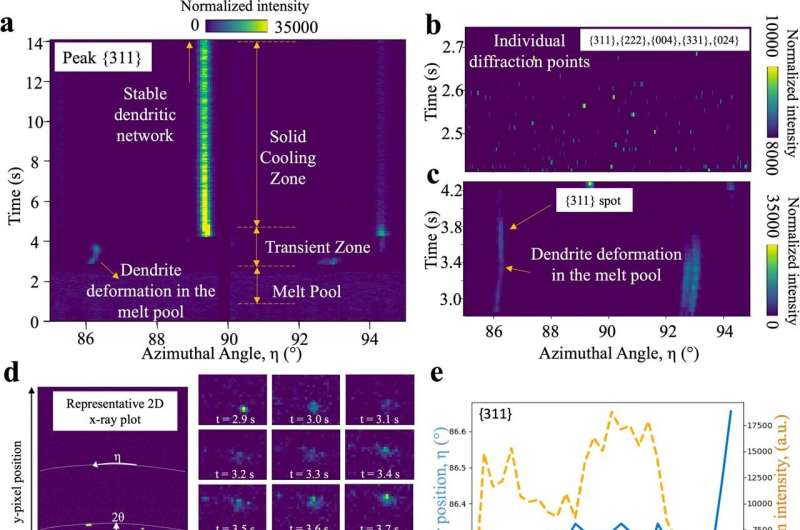This article has been reviewed according to Science X's editorial process and policies. Editors have highlighted the following attributes while ensuring the content's credibility:
fact-checked
trusted source
proofread
X-rays reveal microstructural fingerprints of 3D-printed alloy

Cornell researchers took a novel approach to explore the way microstructure emerges in a 3D-printed metal alloy: They bombarded it with X-rays while the material was being printed.
By seeing how the process of thermomechanical deformation creates localized microscale phenomena such as bending, fragmentation and oscillation in real time, the researchers will be able to produce customized materials that incorporate such performance-enhancing characteristics.
The group's paper, "Dendritic Deformation Modes in Additive Manufacturing Revealed by Operando X-Ray Diffraction," is published in Communications Materials. The lead author is doctoral student Adrita Dass.
"We always look at these microstructures after processing, but there's a lot of information that you're missing by conducting only postmortem characterizations. Now we have tools to be able to watch these microstructural evolutions as they are happening," said Atieh Moridi, assistant professor in the Sibley School of Mechanical and Aerospace Engineering in Cornell Engineering and the paper's senior author.
"We want to be able to understand how these tiny patterns or microstructures are formed because they dictate everything about performance of printed parts."
The group focused on a form of 3D printing in which a powder—in this case, the nickel-based superalloy IN625, widely used in additive manufacturing and the aerospace industry—is applied via nozzle and melted by a high-power laser beam, then cools and solidifies.
Since it is not feasible to access high-energy X-rays in the lab, the researchers created a portable twin of their 3D-printing setup and brought it to the Center for High Energy X-ray Sciences at the Cornell High Energy Synchrotron Source (CHEXS@CHESS), in Wilson Laboratory.
The facility had never conducted this type of 3D-printing experiment before, so the CHESS beamline scientist Darren Pagan, now assistant professor at Pennsylvania State University, worked with the researchers to integrate the printer setup into one of the facility's experiment hutches. The CHESS team also developed crucial safety protocols for operating a high-power laser along with flammable powders.
During the experiment at the FAST beamline, a focused X-ray beam was sent into the hutch, where it passed through the IN625 as it was heated, melted and cooled. A detector on the other side of the printer captured the patterns of diffraction that result from the X-rays interacting with the material.
"The way these diffraction patterns form gives us a lot of information about the structure of the material. They are the microstructural fingerprints that capture the history of the material during the processing," Moridi said. "Depending on the interaction and what caused it, we get different patterns, and from those patterns, we can back calculate the structure of the material."
Typically, researchers would try to consolidate the amount of diffraction data in order to analyze it. But Moridi, Dass and doctoral student and co-author Chenxi Tian took on a more challenging task and studied the raw detector images. While this approach required more time and was more labor-intensive, it provided a richer, holistic picture of how the IN625 took shape, revealing "unique features that most of the time we're missing," Moridi said.
The group identified key microstructural features that were created by the process's thermal and mechanical effects, including: torsion, bending, fragmentation, assimilation, oscillation and interdendritic growth.
The researchers anticipate their method can be applied to other 3D-printed metals, such as stainless steels, titanium and high-entropy alloys, or any material system with a crystal structure.
The method can also help inform the development of sturdier materials. For example, pulsing a laser beam would increase fragmentation inside a crystal and reduce the size of its grains, making the material stronger.
"The final goal is to have the best material system that we can have for that particular alloy for a particular application," Dass said. "If you know what is happening during processing, you can choose how to process your materials, so you get those specific features."
More information: Adrita Dass et al, Dendritic deformation modes in additive manufacturing revealed by operando x-ray diffraction, Communications Materials (2023). DOI: 10.1038/s43246-023-00404-0
Provided by Cornell University




















